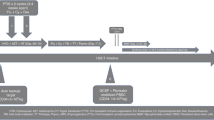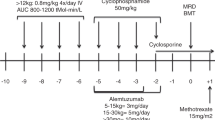Abstract
Multiply transfused patients of severe aplastic anemia are at increased risk of graft rejection. Five such patients underwent peripheral blood stem cell transplantation from HLA-identical siblings with a fludarabine-based protocol. The conditioning consisted of fludarabine 30 mg/m2/day × 6 days, cyclophosphamide 60 mg/kg/day × 2 days and horse antithymocyte globulin (ATG) × 4 days. Two different ATG preparations were used: ATGAM (dose 30 mg/kg/day × 4 days) or Thymogam (dose 40 mg/kg/day × 4 days). Engraftment: median time to absolute neutrophil count (ANC) >0.5 × 109/l was 11 days (range: 8–17) and median time to platelet count >20 × 109/l was 11 days (range: 9–17). At a median follow-up of 171 days (range: 47–389), there has been no graft rejection and all patients are in complete remission. Acute GVHD (grade 1) occurred in one patient only. Chronic GVHD developed in two patients (extensive in one and limited in another). The transplants were performed in non-HEPA filter rooms. In only one patient, systemic antifungal therapy (voriconazole) was used. The use of Thymogam brand of ATG for conditioning is being reported for the first time. Our experience suggests that this fludarabine-based protocol allows rapid sustained engraftment in high-risk patients without significant immediate toxicity.
This is a preview of subscription content, access via your institution
Access options
Subscribe to this journal
Receive 12 print issues and online access
$259.00 per year
only $21.58 per issue
Buy this article
- Purchase on Springer Link
- Instant access to full article PDF
Prices may be subject to local taxes which are calculated during checkout
Similar content being viewed by others
References
Deeg HJ, Self S, Storb R, Doney K, Appelbaum FR, Witherspoon RP et al. Decreased incidence of marrow graft rejection in patients with severe aplastic anemia: changing impact of risk factors. Blood 1986; 68: 1363–1368.
Horowitz MM . Current status of allogeneic bone marrow transplantation in acquired aplastic anemia. Semin Hematol 2000; 37: 30–42.
Chandy M, Srivastava A, Dennison D, Mathews V, George B . Allogeneic bone marrow transplantation in the developing world: experience from a center in India. Bone Marrow Transplant 2001; 27: 785–790.
Kang HJ, Shin HY, Choi HS, Ahn HS . Fludarabine, cyclophosphamide plus thymoglobulin conditioning regimen for unrelated bone marrow transplantation in severe aplastic anemia. Bone Marrow Transplant 2004; 34: 939–943.
Bacigalupo A, Locatelli F, Lanino E, Marsh J, Socie G, Maury S et al. Fludarabine, cyclophosphamide and anti-thymocyte globulin for alternative donor transplants in acquired severe aplastic anemia: a report from the EBMT-SAA Working Party. Bone Marrow Transplant 2005; 36: 947–950.
Johnsen HE, Baech J, Nikolajsen K . Validation of the Nordic flow cytometry standard for CD34+ cell enumeration in blood and autografts: report from the third workshop. Nordic Stem Cell Laboratory Group. J Hematother 1999; 8: 15–28.
Storb R, Prentice RL, Thomas ED, Appelbaum FR, Deeg HJ, Doney K et al. Factors associated with graft rejection after HLA-identical marrow transplantation for aplastic anaemia. Br J Haematol 1983; 55: 573–585.
Storb R, Prentice RL, Thomas ED . Marrow transplantation for treatment of aplastic anemia. An analysis of factors associated with graft rejection. N Engl J Med 1977; 296: 61–66.
Gluckman E, Horowitz MM, Champlin RE, Hows JM, Bacigalupo A, Biggs JC et al. Bone marrow transplantation for severe aplastic anemia: influence of conditioning and graft-versus-host disease prophylaxis regimens on outcome. Blood 1992; 79: 269–275.
Ades L, Mary JY, Robin M, Ferry C, Porcher R, Esperou H et al. Long-term outcome after bone marrow transplantation for severe aplastic anemia. Blood 2004; 103: 2490–2497.
Champlin RE, Horowitz MM, van Bekkum DW, Camitta BM, Elfenbein GE, Gale RP et al. Graft failure following bone marrow transplantation for severe aplastic anemia: risk factors and treatment results. Blood 1989; 73: 606–613.
Storb R, Etzioni R, Anasetti C, Appelbaum FR, Buckner CD, Bensinger W et al. Cyclophosphamide combined with antithymocyte globulin in preparation for allogeneic marrow transplants in patients with aplastic anemia. Blood 1994; 84: 941–949.
Marsh JC, Ball SE, Darbyshire P, Gordon-Smith EC, Keidan AJ, Martin A et al. Guidelines for the diagnosis and management of acquired aplastic anaemia. Br J Haematol 2003; 123: 782–801.
Kahl C, Leisenring W, Deeg HJ, Chauncey TR, Flowers ME, Martin PJ et al. Cyclophosphamide and antithymocyte globulin as a conditioning regimen for allogeneic marrow transplantation in patients with aplastic anaemia: a long-term follow-up. Br J Haematol 2005; 130: 747–751.
Chan KW, Li CK, Worth LL, Chik KW, Jeha S, Shing MK et al. A fludarabine-based conditioning regimen for severe aplastic anemia. Bone Marrow Transplant 2001; 27: 125–128.
George B, Mathews V, Shaji RV, Srivastava V, Srivastava A, Chandy M . Fludarabine-based conditioning for allogeneic stem cell transplantation for multiply transfused patients with Fanconi's anemia. Bone Marrow Transplant 2005; 35: 341–343.
Stem Cell Trialists' Collaborative Group. Allogeneic peripheral blood stem-cell compared with bone marrow transplantation in the management of hematologic malignancies: an individual patient data meta-analysis of nine randomized trials. J Clin Oncol 2005; 23: 5074–5087.
Korbling M, Anderlini P . Peripheral blood stem cell versus bone marrow allotransplantation: does the source of hematopoietic stem cells matter? Blood 2001; 98: 2900–2908.
Bacigalupo A . Antilymphocyte/thymocyte globulin for graft versus host disease prophylaxis: efficacy and side effects. Bone Marrow Transplant 2005; 35: 225–231.
Hayes-Lattin B, Leis JF, Maziarz RT . Isolation in the allogeneic transplant environment: how protective is it? Bone Marrow Transplant 2005; 36: 373–381.
Russell JA, Chaudhry A, Booth K, Brown C, Woodman RC, Valentine K et al. Early outcomes after allogeneic stem cell transplantation for leukemia and myelodysplasia without protective isolation: a 10-year experience. Biol Blood Marrow Transplant 2000; 6: 109–114.
Acknowledgements
We thank Dr A Srivastava and Dr M Chandy (Christian Medical College, Vellore, India) for sharing their experience in using different protocols for BMT in aplastic anemia.
Author information
Authors and Affiliations
Corresponding author
Rights and permissions
About this article
Cite this article
Kumar, R., Prem, S., Mahapatra, M. et al. Fludarabine, cyclophosphamide and horse antithymocyte globulin conditioning regimen for allogeneic peripheral blood stem cell transplantation performed in non-HEPA filter rooms for multiply transfused patients with severe aplastic anemia. Bone Marrow Transplant 37, 745–749 (2006). https://doi.org/10.1038/sj.bmt.1705321
Received:
Revised:
Accepted:
Published:
Issue Date:
DOI: https://doi.org/10.1038/sj.bmt.1705321
Keywords
This article is cited by
-
Idiopathic Aplastic anemia: Indian Perspective
Indian Journal of Hematology and Blood Transfusion (2023)
-
Matched Sibling Versus Matched Unrelated Allogeneic Hematopoietic Stem Cell Transplantation in Children with Severe Acquired Aplastic Anemia: Experience of the Polish Pediatric Group for Hematopoietic Stem Cell Transplantation
Archivum Immunologiae et Therapiae Experimentalis (2012)
-
Allogeneic hematopoietic SCT performed in non-HEPA filter rooms: initial experience from a single center in India
Bone Marrow Transplantation (2009)
-
Reduced-intensity conditioning for severe aplasia using fludarabine and CY followed by infusion of ex vivo T-cell-depleted grafts leads to excellent engraftment and absence of GVHD
Bone Marrow Transplantation (2009)
-
Allogeneic hematopoietic stem cell transplantation for acquired aplastic anemia using cyclophosphamide and antithymocyte globulin: a single center experience
Bone Marrow Transplantation (2009)



